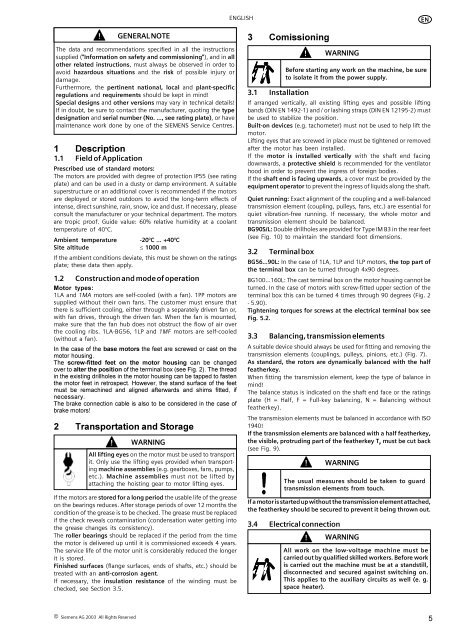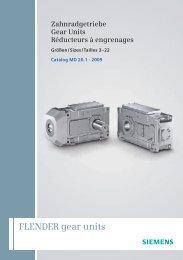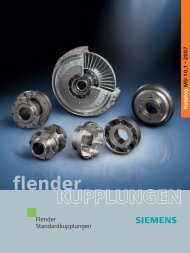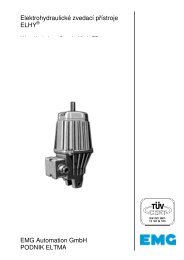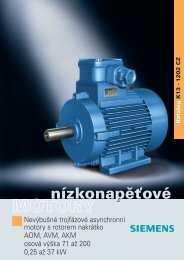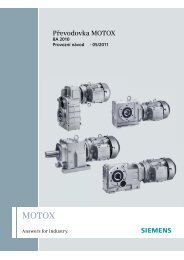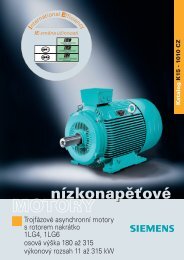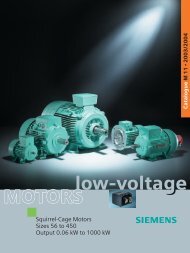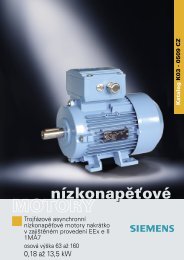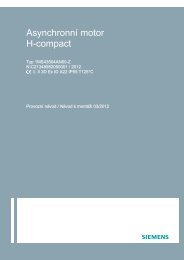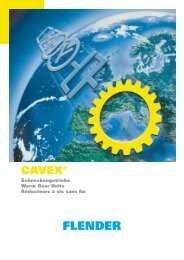Manuál elektromotorů 1LA7/1LA9 - MOTOR-GEAR as
Manuál elektromotorů 1LA7/1LA9 - MOTOR-GEAR as
Manuál elektromotorů 1LA7/1LA9 - MOTOR-GEAR as
You also want an ePaper? Increase the reach of your titles
YUMPU automatically turns print PDFs into web optimized ePapers that Google loves.
The data and recommendations specified in all the instructions<br />
supplied ("Information on safety and commissioning"), and in all<br />
other related instructions, must always be observed in order to<br />
avoid hazardous situations and the risk of possible injury or<br />
damage.<br />
Furthermore, the pertinent national, local and plant-specific<br />
regulations and requirements should be kept in mind!<br />
Special designs and other versions may vary in technical details!<br />
If in doubt, be sure to contact the manufacturer, quoting the type<br />
designation and serial number (No. ..., see rating plate), or have<br />
maintenance work done by one of the SIEMENS Service Centres.<br />
1 Description<br />
1.1 Field of Application<br />
Prescribed use of standard motors:<br />
The motors are provided with degree of protection IP55 (see rating<br />
plate) and can be used in a dusty or damp environment. A suitable<br />
superstructure or an additional cover is recommended if the motors<br />
are deployed or stored outdoors to avoid the long-term effects of<br />
intense, direct sunshine, rain, snow, ice and dust. If necessary, ple<strong>as</strong>e<br />
consult the manufacturer or your technical department. The motors<br />
are tropic proof. Guide value: 60% relative humidity at a coolant<br />
temperature of 40°C.<br />
Ambient temperature -20°C ... +40°C<br />
Site altitude £ 1000 m<br />
If the ambient conditions deviate, this must be shown on the ratings<br />
plate; these data then apply.<br />
1.2 Construction and mode of operation<br />
Motor types:<br />
1LA and 1MA motors are self-cooled (with a fan). 1PP motors are<br />
supplied without their own fans. The customer must ensure that<br />
there is sufficient cooling, either through a separately driven fan or,<br />
with fan drives, through the driven fan. When the fan is mounted,<br />
make sure that the fan hub does not obstruct the flow of air over<br />
the cooling ribs. 1LA-BG56, 1LP and 1MF motors are self-cooled<br />
(without a fan).<br />
In the c<strong>as</strong>e of the b<strong>as</strong>e motors the feet are screwed or c<strong>as</strong>t on the<br />
motor housing.<br />
The screw-fitted feet on the motor housing can be changed<br />
over to alter the position of the terminal box (see Fig. 2). The thread<br />
in the existing drillholes in the motor housing can be tapped to f<strong>as</strong>ten<br />
the motor feet in retrospect. However, the stand surface of the feet<br />
must be remachined and aligned afterwards and shims fitted, if<br />
necessary.<br />
The brake connection cable is also to be considered in the c<strong>as</strong>e of<br />
brake motors!<br />
2 Transportation and Storage<br />
If the motors are stored for a long period the usable life of the gre<strong>as</strong>e<br />
on the bearings reduces. After storage periods of over 12 months the<br />
condition of the gre<strong>as</strong>e is to be checked. The gre<strong>as</strong>e must be replaced<br />
if the check reveals contamination (condensation water getting into<br />
the gre<strong>as</strong>e changes its consistency).<br />
The roller bearings should be replaced if the period from the time<br />
the motor is delivered up until it is commissioned exceeds 4 years.<br />
The service life of the motor unit is considerably reduced the longer<br />
it is stored.<br />
Finished surfaces (flange surfaces, ends of shafts, etc.) should be<br />
treated with an anti-corrosion agent.<br />
If necessary, the insulation resistance of the winding must be<br />
checked, see Section 3.5.<br />
ã Siemens AG 2003 All Rights Reserved<br />
GENERAL NOTE<br />
WARNING<br />
All lifting eyes on the motor must be used to transport<br />
it. Only use the lifting eyes provided when transporting<br />
machine <strong>as</strong>semblies (e.g. gearboxes, fans, pumps,<br />
etc.). Machine <strong>as</strong>semblies must not be lifted by<br />
attaching the hoisting gear to motor lifting eyes.<br />
ENGLISH<br />
3 Comissioning<br />
WARNING<br />
Before starting any work on the machine, be sure<br />
to isolate it from the power supply.<br />
3.1 Installation<br />
If arranged vertically, all existing lifting eyes and possible lifting<br />
bands (DIN EN 1492-1) and / or l<strong>as</strong>hing straps (DIN EN 12195-2) must<br />
be used to stabilize the position.<br />
Built-on devices (e.g. tachometer) must not be used to help lift the<br />
motor.<br />
Lifting eyes that are screwed in place must be tightened or removed<br />
after the motor h<strong>as</strong> been installed.<br />
If the motor is installed vertically with the shaft end facing<br />
downwards, a protective shield is recommended for the ventilator<br />
hood in order to prevent the ingress of foreign bodies.<br />
If the shaft end is facing upwards, a cover must be provided by the<br />
equipment operator to prevent the ingress of liquids along the shaft.<br />
Quiet running: Exact alignment of the coupling and a well-balanced<br />
transmission element (coupling, pulleys, fans, etc.) are essential for<br />
quiet vibration-free running. If necessary, the whole motor and<br />
transmission element should be balanced.<br />
BG90S/L: Double drillholes are provided for Type IM B3 in the rear feet<br />
(see Fig. 10) to maintain the standard foot dimensions.<br />
3.2 Terminal box<br />
BG56...90L: In the c<strong>as</strong>e of 1LA, 1LP and 1LP motors, the top part of<br />
the terminal box can be turned through 4x90 degrees.<br />
BG100...160L: The c<strong>as</strong>t terminal box on the motor housing cannot be<br />
turned. In the c<strong>as</strong>e of motors with screw-fitted upper section of the<br />
terminal box this can be turned 4 times through 90 degrees (Fig. 2<br />
- 5.90).<br />
Tightening torques for screws at the electrical terminal box see<br />
Fig. 5.2.<br />
3.3 Balancing, transmission elements<br />
A suitable device should always be used for fitting and removing the<br />
transmission elements (couplings, pulleys, pinions, etc.) (Fig. 7).<br />
As standard, the rotors are dynamically balanced with the half<br />
featherkey.<br />
When fitting the transmission element, keep the type of balance in<br />
mind!<br />
The balance status is indicated on the shaft end face or the ratings<br />
plate (H = Half, F = Full-key balancing, N = Balancing without<br />
featherkey).<br />
The transmission elements must be balanced in accordance with ISO<br />
1940!<br />
If the transmission elements are balanced with a half featherkey,<br />
the visible, protruding part of the featherkey T must be cut back<br />
P<br />
(see Fig. 9).<br />
WARNING<br />
The usual me<strong>as</strong>ures should be taken to guard<br />
transmission elements from touch.<br />
If a motor is started up without the transmission element attached,<br />
the featherkey should be secured to prevent it being thrown out.<br />
3.4 Electrical connection<br />
WARNING<br />
EN<br />
All work on the low-voltage machine must be<br />
carried out by qualified skilled workers. Before work<br />
is carried out the machine must be at a standstill,<br />
disconnected and secured against switching on.<br />
This applies to the auxiliary circuits <strong>as</strong> well (e. g.<br />
space heater).<br />
5


